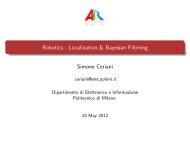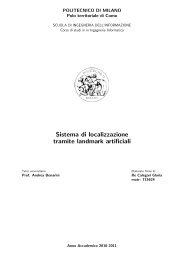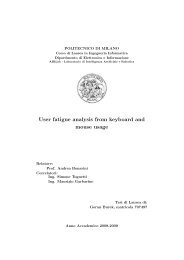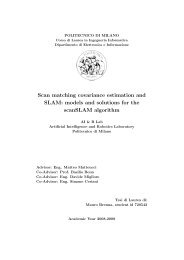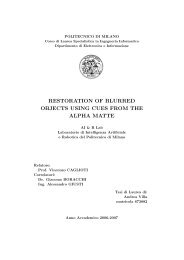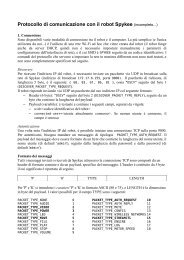Submitted version of the thesis - Airlab, the Artificial Intelligence ...
Submitted version of the thesis - Airlab, the Artificial Intelligence ...
Submitted version of the thesis - Airlab, the Artificial Intelligence ...
You also want an ePaper? Increase the reach of your titles
YUMPU automatically turns print PDFs into web optimized ePapers that Google loves.
5.3. Tracking 65<br />
any color values. It means, if <strong>the</strong> object is exposed to light, <strong>the</strong> parts that<br />
are exposed to light are not considered as white but a tone <strong>of</strong> target color,<br />
similarly with <strong>the</strong> previous configuration <strong>the</strong> dark pixel such as <strong>the</strong> parts in<br />
<strong>the</strong> shadow are considered as black, but with <strong>the</strong> new configuration <strong>the</strong>y are<br />
also considered as a tone <strong>of</strong> <strong>the</strong> target color.<br />
Second step is calculation <strong>of</strong> <strong>the</strong> color information in a better way. Previously,<br />
we calculated <strong>the</strong> information by ST color picker s<strong>of</strong>tware. With<br />
this s<strong>of</strong>tware we select <strong>the</strong> color region we want to assume as <strong>the</strong> blob color.<br />
The problem <strong>of</strong> this approach is that <strong>the</strong> blob may not consists <strong>of</strong> a single<br />
rule (RGB color code). Some parts <strong>of</strong> <strong>the</strong> object are darker, some parts<br />
are lighter. Also with <strong>the</strong> distance, <strong>the</strong> color that is composing <strong>the</strong> object<br />
is changing. Additionally, <strong>the</strong> colors that are not considered as red, blue,<br />
green, represented again as rules (RGB color codes) and it is not possible to<br />
understand by just looking at <strong>the</strong> color code whe<strong>the</strong>r it is <strong>the</strong> correct color<br />
coding or not. These makes it very difficult to determine <strong>the</strong> color with <strong>the</strong><br />
ST color picker s<strong>of</strong>tware. Instead, we decided to find <strong>the</strong> color histogram<br />
that is <strong>the</strong> distribution <strong>of</strong> <strong>the</strong> selected color properly in <strong>the</strong> RGB channels<br />
separately. To do so, we took several samples from <strong>the</strong> camera, in different<br />
distances, in different illuminations to find a proper average. The calculated<br />
results are later tested with <strong>the</strong> ST color picker s<strong>of</strong>tware, since it <strong>of</strong>fers a<br />
good interface to see whe<strong>the</strong>r <strong>the</strong> color is selected correct or not, in a visual<br />
way.<br />
The third step is related to <strong>the</strong> estimation <strong>of</strong> <strong>the</strong> objects distance to <strong>the</strong><br />
robot. As mentioned before, <strong>the</strong> diameter <strong>of</strong> <strong>the</strong> ball is a problematic issue<br />
due to <strong>the</strong> low-cost optics, hence we decided to use an object with cylindric<br />
shape, and <strong>the</strong> second configuration for <strong>the</strong> transformation. This distance<br />
is easier to measure, independently from <strong>the</strong> shape <strong>of</strong> <strong>the</strong> object, and will<br />
always change as <strong>the</strong> object’s position changes in <strong>the</strong> world.<br />
During <strong>the</strong> implementation to <strong>the</strong> microcontroller to increase <strong>the</strong> performance,<br />
we tried to avoid matrix and floating point operations. The matrices<br />
that can be defined statically are defined statically. To avoid floating point<br />
operations, <strong>the</strong> floating points are converted into integer, <strong>the</strong>n multiplied by<br />
a constant (most <strong>of</strong> <strong>the</strong> times 1000). The operations are made in integer,<br />
and <strong>the</strong> result is returned as floating point by dividing with <strong>the</strong> constant.<br />
We ensure that <strong>the</strong> microcontroller will not spend too much time in matrix<br />
and floating point operations, using this approach.




